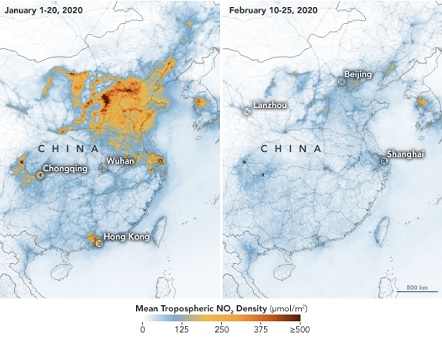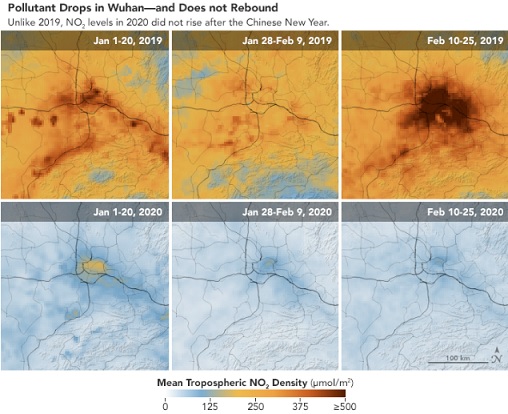新型コロナの感染対策で大気汚染が劇的に改善
アメリカ航空宇宙局(NASA)は中国の大気中の二酸化窒素が大幅に減少していることを発表しました。
NASA earth ovservatory (2020/3/2)
Airborne Nitrogen Dioxide Plummets Over China

上の写真は二酸化窒素の濃度の比較ですが、左側が春節前の2020年1/1~1/20、右側が春節後の2/10~2/25です。
大気汚染が劇的に改善していることが分かります。
次の写真は武漢(Wuhan)の2019年と2020年の二酸化窒素濃度の比較です。

The drop in nitrogen dioxide in 2020 also coincided with Lunar New Year celebrations in China and much of Asia. Generally, businesses and factories close from the last week in January into early February to celebrate the festival. Past observations have shown that air pollution usually decreases during this period and then increases once the celebration is over.
“There is always this general slowdown around this time of the year,” said Barry Lefer, an air quality scientist at NASA. “Our long-term OMI data allows us to see if these amounts are abnormal and why.” Launched in 2004, OMI has been collecting global data on NO2 and various air pollutants for more than 15 years.
The maps above show NO2 values over three periods in 2020: January 1-20 (before Lunar New Year), January 28-February 9 (around New Year celebrations), and February 10-25 (after the event). The 2020 values are compared to the same periods in 2019 for reference. Lefer noted that the overall values in 2020 were lower than 2019 due to new environmental regulations that China has enforced over the past few years.
While the Lunar New Year may have played a role in the recent dropoff, researchers believe the decrease is more than a holiday effect or weather-related variation. In a preliminary analysis, NASA researchers compared NO2 values detected by OMI in 2020 with the average amounts detected at this time of year from 2005-2019. In 2020, NO2 values in eastern and central China were significantly lower (from 10 to 30 percent lower) than what is normally observed for this time period.
Additionally, Liu and colleagues have not seen a rebound in NO2 after the holiday. “This year, the reduction rate is more significant than in past years and it has lasted longer,” she said. “I am not surprised because many cities nationwide have taken measures to minimize spread of the virus.”
以下はGoogleの翻訳です。
2020年の二酸化窒素の減少は、中国とアジアの多くでの旧正月の祝賀とも一致しました。一般的に、企業と工場は、フェスティバルを祝うために、1月の最後の週から2月の初めに閉まります。過去の観測では、大気汚染は通常この期間中に減少し、お祝いが終わると増加することが示されています。
NASAの大気質科学者であるバリーリーファーは、次のように述べています。 「当社の長期OMIデータにより、これらの量が異常であるかどうか、およびその理由を確認できます。」 2004年に開始されたOMIは、NO2およびさまざまな大気汚染物質に関する15年以上にわたるグローバルデータを収集しています。
上記のマップは、2020年の3つの期間(1月1日から20日(旧正月前)、1月28日から2月9日(新年のお祝い)、2月10日から25日(イベント後))のNO2値を示しています。 2020年の値は、参考のために2019年の同じ期間と比較されます。 Leferは、中国が過去数年間に施行した新しい環境規制により、2020年の全体的な値は2019年よりも低いと指摘しました。
旧正月は最近の降車で役割を果たした可能性がありますが、研究者たちはこの減少は休日の影響や天候関連の変動以上のものであると考えています。予備分析では、NASAの研究者は、2020年にOMIによって検出されたNO2値を、2005年から2019年のこの時期に検出された平均量と比較しました。 2020年には、中国東部および中部のNO2値は、この期間に通常観察される値よりも大幅に低かった(10 030%低下)。
さらに、Li氏と同僚は、休暇後にNO2の反発を見ていません。 「今年、削減率は過去数年よりも重要であり、より長く続いた」と彼女は言った。 「全国の多くの都市がウイルスの拡散を最小限に抑える対策を講じているので、私は驚くことではありません。」
写真を見ると、春節前でも2020年は2019年よりNO2が大幅に減少していますが、それは中国が行ってきた環境規制の成果だそうです。
2019年は春節期間(1/28-2/9)の後はNO2が大幅に増加していますが、これが例年のパターンのようです。
ところが2020年は春節が終わっても増加していません。
写真をよく見ると、むしろ春節後の方がNO2が減っているような感じもします。
テレビでも車が全く走っていない武漢の映像が流れていましたが、このNO2の減少は都市の封鎖による影響が大きそうです。
それにしても、新型コロナウイルスという人類の大敵によって地球環境が改善するという、実に皮肉な現象だと思います。
人類を脅かすウイルスの発生というのは、自然界の壮大な修復機能の1つなのでしょうか。
ちなみに、これだけ大気汚染が改善していたら、日射量も結構増加している可能性があります。
太陽光発電の電力が増えて、さらに環境には良い方向になっていそうです。
もしかしたら、
気付いたら、環境の面でも中国は日本の先に行っていた。
ということになるかもしれません。